The machine glazed paper market is valued at USD 4.2 billion in 2025 and is projected to reach USD 7.1 billion by 2035, rising at a 5.4% CAGR, with growth progressing steadily as food service, packaging, and commercial printing sectors shift toward barrier-enhanced, grease-resistant, and high-printability substrates. Demand is reinforced by expansion in bakery, confectionery, and quick-service restaurant formats where moisture and oil protection are essential, as well as rising use in pharmaceutical wrapping and industrial packaging applications seeking improved surface smoothness and coating stability. Single-sided machine glazed papers, representing 52.3% of demand, remain the primary category due to their optimal balance of cost efficiency, barrier performance, and compatibility with high-volume wrapping and food contact applications. Food packaging, accounting for 38.5% of total usage, anchors overall consumption as operators prioritize consistent barrier reliability, hygienic handling performance, and print-ready surfaces suited for branding and regulatory labeling.
Growth is led by India (7.8% CAGR) and China (6.9%), where expanding food service ecosystems, rapid packaged food penetration, and large-scale manufacturing capacity upgrades accelerate material adoption. The United States (4.7%), Germany (4.9%), and Japan (4.3%) show stable, technology-driven demand tied to advanced coating processes, digital printing compatibility, and high-quality production standards. Competitive dynamics are shaped by large paper manufacturers with integrated coating, calendering, and surface-treatment capabilities. Companies such as Mondi, International Paper, Stora Enso, UPM-Kymmene, Sappi, and Nippon Paper maintain an advantage through investments in barrier enhancement, recyclable formulations, and precision manufacturing systems. The emerging differentiators include coating uniformity, moisture–grease barrier optimization, and print surface engineering rather than basic paper weight or cost.
A major dynamic behind market expansion is the rising consumption of packaged and quick-service foods. MG paper is widely used for bakery wraps, sandwich bags, confectionery packaging, and takeaway solutions due to its grease resistance (when treated), visual appeal, and ability to maintain product freshness. Retail bakeries, café chains, fast-food outlets, and ready-to-eat food providers rely on MG paper for its balance of strength and formability. Growth in out-of-home food consumption, expansion of modern retail, and urban dietary shifts all reinforce steady demand.
Technology advancements are shaping product development. Modern MG machines deliver improved formation, cleaner surfaces, higher bulk, and better gloss uniformity. Coated MG papers engineered with grease-resistant, moisture-resistant, and barrier coatings expand application possibilities in food and non-food sectors. Precision moisture control, enhanced fillers, and optimized fiber blends further improve print clarity and machinability.
| Metric | Value |
|---|---|
| Estimated Value in (2025E) | USD 4.2 billion |
| Forecast Value in (2035F) | USD 7.1 billion |
| Forecast CAGR (2025 to 2035) | 5.4% |
Market expansion is being supported by the increasing global demand for food packaging solutions and the corresponding need for barrier papers that can provide superior grease resistance and moisture protection while enabling cost-effective packaging formats and enhanced printability across various food service, publishing, and industrial wrapping applications. Modern food packaging facilities and commercial printing operations are increasingly focused on implementing machine glazed paper solutions that can optimize barrier performance, reduce material costs, and provide consistent quality throughout high-volume production operations. Machine glazed paper technology's proven ability to deliver exceptional surface smoothness, enable efficient printing processes, and support diverse application requirements make them essential materials for contemporary food packaging and printing operations.
The growing emphasis on food safety regulations and packaging performance is driving demand for machine glazed papers that can support barrier requirements, improve product protection, and enable advanced coating applications. Manufacturers' preference for materials that combine effective moisture resistance with enhanced printability and processing efficiency is creating opportunities for innovative machine glazed paper implementations. The rising influence of quick-service restaurants and retail food packaging is also contributing to increased demand for machine glazed papers that can provide reliable barrier protection, handling durability, and distinctive printing quality across diverse food service categories.
The machine glazed paper market is poised for robust growth and transformation. As industries across food packaging, publishing, pharmaceuticals, and industrial applications seek materials that deliver exceptional barrier properties, printing quality, and processing efficiency, machine glazed papers are gaining prominence not just as specialty papers but as strategic enablers of packaging performance and production optimization.
Rising food service consumption in developing markets and expanding e-commerce packaging requirements globally amplify demand, while manufacturers are leveraging innovations in coating technologies, calendering processes, and barrier enhancement systems.
Pathways like enhanced barrier coatings, digital printing compatibility, and application-specific formulations promise strong margin uplift, especially in high-value segments. Geographic expansion and technology partnerships will capture volume, particularly where local food service growth and printing industry proximity are critical. Regulatory pressures around food safety requirements, packaging migration standards, production quality guidelines, and recycling compatibility specifications give structural support.
The market is segmented by paper type, coating technology, grammage, application, end-use industry, barrier level, and region. By paper type, the market is divided into single-sided machine glazed papers, double-sided machine glazed papers, and specialty machine glazed papers. By coating technology, it covers polyethylene coating, wax coating, and clay coating. By grammage, it includes lightweight (below 40 GSM), medium-weight (40-80 GSM), and heavyweight (above 80 GSM). By application, it covers food packaging, industrial wrapping, publishing & printing, pharmaceutical packaging, and others. By end-use industry, it is categorized into food & beverages, publishing & printing, pharmaceuticals & healthcare, industrial manufacturing, and consumer goods. By barrier level, it covers standard barrier, enhanced barrier, and specialty barrier. Regionally, the market is divided into North America, Europe, East Asia, South Asia & Pacific, Latin America, and the Middle East & Africa.
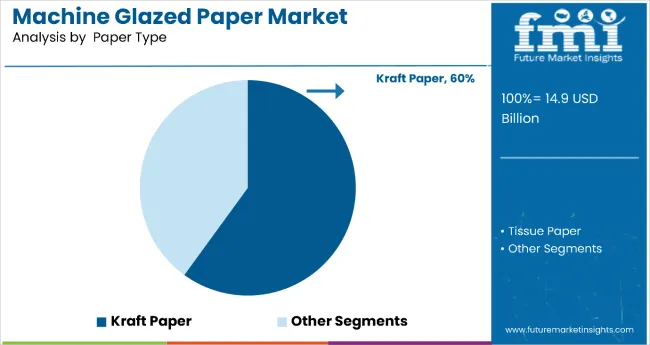
The single-sided machine glazed papers segment is projected to account for 52.3% of the machine glazed paper market in 2025, reaffirming its position as the leading paper type category. Food packaging manufacturers and industrial users increasingly utilize single-sided machine glazed papers for their optimal cost-effectiveness, excellent barrier properties on the critical surface, and widespread adoption in food wrapping, bakery applications, and industrial packaging uses. The single-sided glazing technology's established industry standardization and consistent performance characteristics directly address the industrial requirements for reliable barrier protection in high-volume production environments.
This paper type segment forms the foundation of modern food packaging operations, as it represents the machine glazed technology with the greatest market penetration and established demand across multiple food service categories and global markets. Manufacturer investments in enhanced coating precision and advanced calendering technologies continue to strengthen adoption among food packagers and industrial users. With companies prioritizing cost efficiency and barrier performance, single-sided machine glazed papers align with both economic requirements and functional objectives, making them the central component of comprehensive packaging strategies.
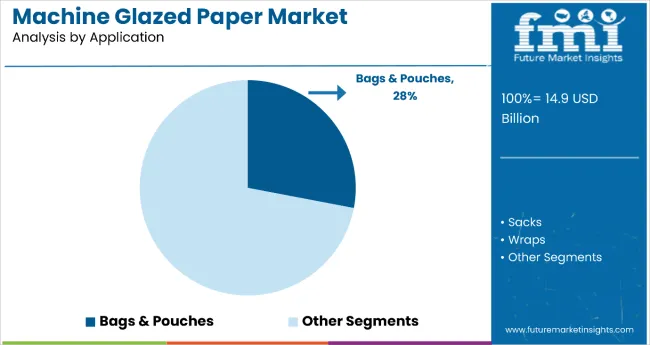
Food packaging applications are projected to represent 38.5% of machine glazed paper demand in 2025, underscoring their critical role as the primary industrial consumers of machine glazed materials for food service wrapping, bakery product packaging, and fast food container applications. Food packaging manufacturers prefer machine glazed papers for their exceptional grease resistance, superior moisture barrier properties, and ability to accommodate diverse food contact requirements while ensuring food safety compliance and handling durability. Positioned as essential packaging materials for modern food service and retail food operations, machine glazed papers offer both functional advantages and cost-effectiveness benefits.
The segment is supported by continuous innovation in barrier coating technologies and the growing availability of specialized formulations that enable food safety compliance with enhanced barrier performance and printing compatibility. Additionally, food service operators are investing in integrated packaging solutions to support large-volume machine glazed paper utilization and operational efficiency. As food service consumption becomes more prevalent and packaging requirements increase, food packaging applications will continue to dominate the end-use market while supporting advanced barrier integration and performance optimization strategies.
The machine glazed paper market is advancing steadily due to increasing demand for barrier packaging materials in food service industries and growing adoption of high-quality printing papers that provide superior surface smoothness and ink holdout while enabling cost reduction across diverse food packaging, publishing, and industrial applications. However, the market faces challenges, including competition from plastic packaging alternatives, fluctuating raw material costs, and the need for specialized manufacturing equipment for coating processes. Innovation in barrier coating technologies and advanced surface treatment methods continues to influence product development and market expansion patterns.
The growing adoption of polyethylene extrusion coating, wax impregnation systems, and specialized barrier additives is enabling manufacturers to produce machine glazed papers with superior moisture resistance, enhanced grease barrier properties, and multi-functional surface characteristics. Advanced coating systems provide improved barrier performance while allowing more efficient high-speed processing and consistent quality across various food contact applications and industrial uses. Manufacturers are increasingly recognizing the competitive advantages of enhanced coating capabilities for performance differentiation and market expansion.
Modern machine glazed paper producers are incorporating specialized surface treatments, controlled porosity systems, and ink receptivity enhancements to improve print quality, enable variable data printing, and deliver value-added printing solutions to commercial printing and packaging customers. These technologies improve printing consistency while enabling new application capabilities, including high-resolution graphics, shortened print runs, and personalized packaging. Advanced surface optimization also allows manufacturers to support premium printing applications and specialized graphic requirements beyond traditional barrier approaches.
| Country | CAGR (2025-2035) |
|---|---|
| India | 7.8% |
| China | 6.9% |
| USA | 4.7% |
| Brazil | 6.2% |
| Germany | 4.9% |
| Japan | 4.3% |
| Italy | 5.1% |
The machine glazed paper market is experiencing solid growth globally, with India leading at a 7.8% CAGR through 2035, driven by the expanding food service industry, growing packaging requirements, and significant investment in paper manufacturing infrastructure. China follows at 6.9%, supported by rapid food packaging consumption growth, increasing domestic paper production, and growing export packaging demand. The USA shows growth at 4.7%, emphasizing advanced coating technologies and high-quality printing applications. Brazil records 6.2%, focusing on food service expansion and growing packaged food consumption. Germany demonstrates 4.9% growth, prioritizing precision manufacturing standards and advanced paper production excellence. Japan exhibits 4.3% growth, emphasizing quality control and efficient production systems. Italy shows 5.1% growth, supported by food packaging industry modernization and paper manufacturing innovation.
The report covers an in-depth analysis of 40+ countries top-performing countries are highlighted below.
Revenue from machine glazed papers in India is projected to exhibit exceptional growth with a CAGR of 7.8% through 2035, driven by expanding food service operations and rapidly growing packaged food consumption supported by urbanization trends promoting modern retail distribution. The country's strong position in food processing manufacturing and increasing investment in paper production infrastructure are creating substantial demand for machine glazed paper solutions. Major food service operators and packaging manufacturers are establishing comprehensive material sourcing capabilities to serve both domestic packaging demand and export food packaging markets.
Revenue from machine glazed papers in China is expanding at a CAGR of 6.9%, supported by the country's massive food service market, expanding packaging production activities, and increasing adoption of barrier packaging solutions. The country's government initiatives promoting manufacturing modernization and growing middle-class consumption are driving requirements for sophisticated barrier paper capabilities. International suppliers and domestic manufacturers are establishing extensive production and distribution capabilities to address the growing demand for machine glazed paper products.
Revenue from machine glazed papers in the USA is expanding at a CAGR of 4.7%, supported by the country's advanced paper manufacturing sector, strong emphasis on food safety compliance, and robust demand for high-performance materials in food service and printing applications. The nation's mature industrial sector and technology-focused operations are driving sophisticated coating systems throughout the supply chain. Leading manufacturers and technology providers are investing extensively in barrier technologies and surface treatments to serve both domestic and international markets.
Revenue from machine glazed papers in Brazil is growing at a CAGR of 6.2%, driven by the country's expanding food service industry, growing consumer food packaging sector, and increasing investment in modern paper production facilities. Brazil's large domestic market and commitment to manufacturing modernization are supporting demand for machine glazed paper solutions across multiple application segments. Manufacturers are establishing comprehensive production capabilities to serve the growing domestic market and regional export opportunities.
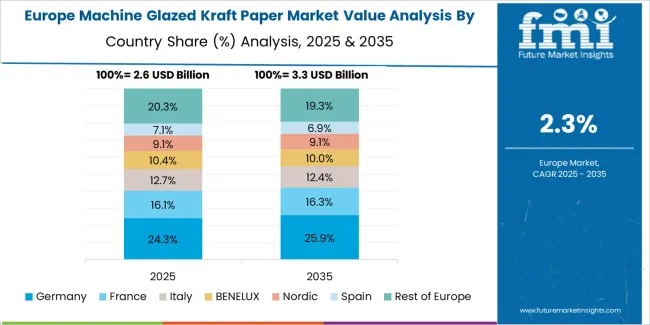
Revenue from machine glazed papers in Germany is expanding at a CAGR of 4.9%, supported by the country's precision manufacturing leadership, advanced paper production capabilities, and strategic focus on high-quality specialty papers. Germany's technical excellence and engineering focus are driving demand for machine glazed papers in food packaging, commercial printing, and industrial applications. Manufacturers are investing in comprehensive coating capabilities to serve both domestic producers and international specialty markets.
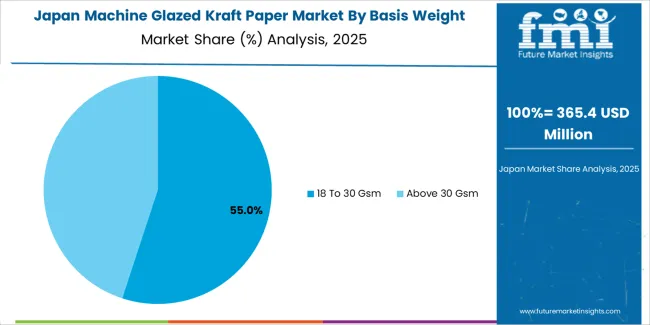
Revenue from machine glazed papers in Japan is growing at a CAGR of 4.3%, driven by the country's expertise in precision paper manufacturing, emphasis on quality assurance, and strong position in food packaging and printing applications. Japan's established paper technology capabilities and commitment to excellence are supporting investment in advanced production technologies throughout major manufacturing centers. Industry leaders are establishing comprehensive quality systems to serve domestic food service operators and printing companies.
Revenue from machine glazed papers in Italy is expanding at a CAGR of 5.1%, supported by the country's food service concentration, growing paper manufacturing sector, and strategic position in European packaging markets. Italy's paper manufacturing capabilities and integrated production infrastructure are driving demand for high-quality machine glazed papers in food packaging, commercial printing, and specialty applications. Leading manufacturers are investing in specialized capabilities to serve the requirements of diverse food service and printing industries.
The machine glazed paper market in Europe is projected to grow from USD 1.1 billion in 2025 to USD 1.8 billion by 2035, registering a CAGR of 5.0% over the forecast period. Germany is expected to maintain its leadership position with a 28.7% market share in 2025, declining slightly to 28.3% by 2035, supported by its strong precision manufacturing base, advanced paper production capabilities, and comprehensive food packaging and commercial printing sector serving diverse machine glazed paper applications across Europe.
Italy follows with a 22.1% share in 2025, projected to reach 22.6% by 2035, driven by robust demand for machine glazed papers in food packaging, printing applications, and paper manufacturing, combined with established industrial infrastructure and export-oriented production expertise. France holds a 18.9% share in 2025, expected to reach 19.2% by 2035, supported by strong food service production and growing packaging automation adoption. The United Kingdom commands a 14.2% share in 2025, projected to reach 14.5% by 2035, while Spain accounts for 8.6% in 2025, expected to reach 8.9% by 2035. Poland maintains a 4.1% share in 2025, growing to 4.2% by 2035. The Rest of Europe region, including Nordic countries, Eastern Europe, Netherlands, Switzerland, and other nations, is anticipated to maintain momentum, with its collective share moving from 3.4% to 2.3% by 2035, attributed to increasing food service growth in Eastern Europe and growing specialty packaging in Nordic countries implementing advanced barrier programs.
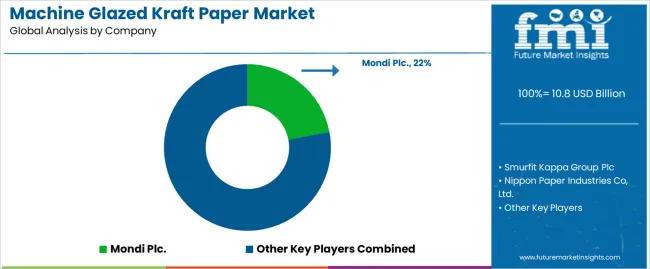
The machine glazed paper market is characterized by competition among established paper manufacturers, specialized coating technology providers, and integrated packaging solutions suppliers. Companies are investing in coating technology research, calendering system optimization, barrier enhancement development, and comprehensive product portfolios to deliver consistent, high-performance, and application-specific machine glazed paper solutions. Innovation in surface treatments, barrier technologies, and processing capabilities is central to strengthening market position and competitive advantage.
Mondi Group leads the market with 22% share, offering comprehensive machine glazed paper solutions with a focus on food packaging and industrial applications. It provides specialized paper manufacturing capabilities with an emphasis on barrier packaging and high-quality printing systems. Stora Enso delivers innovative paper products with a focus on coating technologies and processing efficiency. UPM-Kymmene Corporation specializes in specialty papers and surface treatment solutions for food service applications. Sappi Limited focuses on printing papers and coating equipment with integrated production solutions. Nippon Paper Industries offers specialized machine glazed papers for Asian markets and distribution applications with emphasis on quality consistency.
| Items | Values |
|---|---|
| Quantitative Units (2025) | USD 4.2 billion |
| Paper Type | Single-Sided Machine Glazed Papers, Double-Sided Machine Glazed Papers, Specialty Machine Glazed Papers |
| Coating Technology | Polyethylene Coating, Wax Coating, Clay Coating |
| Grammage | Lightweight (below 40 GSM), Medium-Weight (40-80 GSM), Heavyweight (above 80 GSM) |
| Application | Food Packaging, Industrial Wrapping, Publishing & Printing, Pharmaceutical Packaging, Others |
| End-Use Industry | Food & Beverages, Publishing & Printing, Pharmaceuticals & Healthcare, Industrial Manufacturing, Consumer Goods |
| Barrier Level | Standard Barrier, Enhanced Barrier, Specialty Barrier |
| Regions Covered | North America, Europe, East Asia, South Asia & Pacific, Latin America, Middle East & Africa |
| Countries Covered | United States, Canada, United Kingdom, Germany, France, Italy, China, Japan, South Korea, India, Brazil, Australia and 40+ countries |
| Key Companies Profiled | International Paper Company, Mondi Group, Stora Enso, UPM-Kymmene Corporation, Sappi Limited, and Nippon Paper Industries |
| Additional Attributes | Dollar sales by paper type and application category, regional demand trends, competitive landscape, technological advancements in coating systems, barrier enhancement development, surface treatment innovation, and food safety compliance |
The global machine glazed paper market is estimated to be valued at USD 4.2 billion in 2025.
The market size for the machine glazed paper market is projected to reach USD 7.1 billion by 2035.
The machine glazed paper market is expected to grow at a 5.4% CAGR between 2025 and 2035.
The key product types in machine glazed paper market are single-sided machine glazed papers, double-sided machine glazed papers and specialty machine glazed papers.
In terms of application, food packaging segment to command 38.5% share in the machine glazed paper market in 2025.






Our Research Products

The "Full Research Suite" delivers actionable market intel, deep dives on markets or technologies, so clients act faster, cut risk, and unlock growth.

The Leaderboard benchmarks and ranks top vendors, classifying them as Established Leaders, Leading Challengers, or Disruptors & Challengers.

Locates where complements amplify value and substitutes erode it, forecasting net impact by horizon

We deliver granular, decision-grade intel: market sizing, 5-year forecasts, pricing, adoption, usage, revenue, and operational KPIs—plus competitor tracking, regulation, and value chains—across 60 countries broadly.

Spot the shifts before they hit your P&L. We track inflection points, adoption curves, pricing moves, and ecosystem plays to show where demand is heading, why it is changing, and what to do next across high-growth markets and disruptive tech

Real-time reads of user behavior. We track shifting priorities, perceptions of today’s and next-gen services, and provider experience, then pace how fast tech moves from trial to adoption, blending buyer, consumer, and channel inputs with social signals (#WhySwitch, #UX).

Partner with our analyst team to build a custom report designed around your business priorities. From analysing market trends to assessing competitors or crafting bespoke datasets, we tailor insights to your needs.
Supplier Intelligence
Discovery & Profiling
Capacity & Footprint
Performance & Risk
Compliance & Governance
Commercial Readiness
Who Supplies Whom
Scorecards & Shortlists
Playbooks & Docs
Category Intelligence
Definition & Scope
Demand & Use Cases
Cost Drivers
Market Structure
Supply Chain Map
Trade & Policy
Operating Norms
Deliverables
Buyer Intelligence
Account Basics
Spend & Scope
Procurement Model
Vendor Requirements
Terms & Policies
Entry Strategy
Pain Points & Triggers
Outputs
Pricing Analysis
Benchmarks
Trends
Should-Cost
Indexation
Landed Cost
Commercial Terms
Deliverables
Brand Analysis
Positioning & Value Prop
Share & Presence
Customer Evidence
Go-to-Market
Digital & Reputation
Compliance & Trust
KPIs & Gaps
Outputs
Full Research Suite comprises of:
Market outlook & trends analysis
Interviews & case studies
Strategic recommendations
Vendor profiles & capabilities analysis
5-year forecasts
8 regions and 60+ country-level data splits
Market segment data splits
12 months of continuous data updates
DELIVERED AS:
PDF EXCEL ONLINE
Machine Glazed Paper Industry Analysis in Asia Pacific Forecast Outlook 2025 to 2035
Machine Glazed Paper Industry Analysis in Western Europe Size and Share Forecast Outlook 2025 to 2035
Machine Glazed Paper Industry Analysis in Korea Size and Share Forecast Outlook 2025 to 2035
Machine Glazed Paper Industry Analysis in Japan Size and Share Forecast Outlook 2025 to 2035
Key Players & Market Share in Machine Glazed Paper Industry
Machine Glazed Kraft Paper Market Forecast and Outlook 2025 to 2035
Paper Machine Systems Market
Paper Cup Machine Market Size and Share Forecast Outlook 2025 to 2035
Competitive Overview of Paper Cup Machine Market Share
Paper Making Machines Market
Paper Loading Machine Market Trend Analysis Based on Product, End-Use, Loading Mechanism, Machine Size/Capacity, Automation Level and Regions 2025 to 2035
Kraft Paper Machine Market Analysis - Size, Share, and Forecast Outlook 2025 to 2035
Paper Core Cutting Machine Market Size and Share Forecast Outlook 2025 to 2035
Paper Napkin Making Machine Market Analysis, Size, Share & Forecast 2025 to 2035
Paper Napkins Converting Machines Market Size and Share Forecast Outlook 2025 to 2035
Corrugated Paper Machine Market Size and Share Forecast Outlook 2025 to 2035
Competitive Overview of Corrugated Paper Machine Market Share
Tissue Paper Embosser Machine Market Size and Share Forecast Outlook 2025 to 2035
Tissue Paper Unwinding Machine Market Size and Share Forecast Outlook 2025 to 2035
Competitive Overview of Tissue Paper Unwinding Machine Manufacturers

Thank you!
You will receive an email from our Business Development Manager. Please be sure to check your SPAM/JUNK folder too.
Chat With
MaRIA